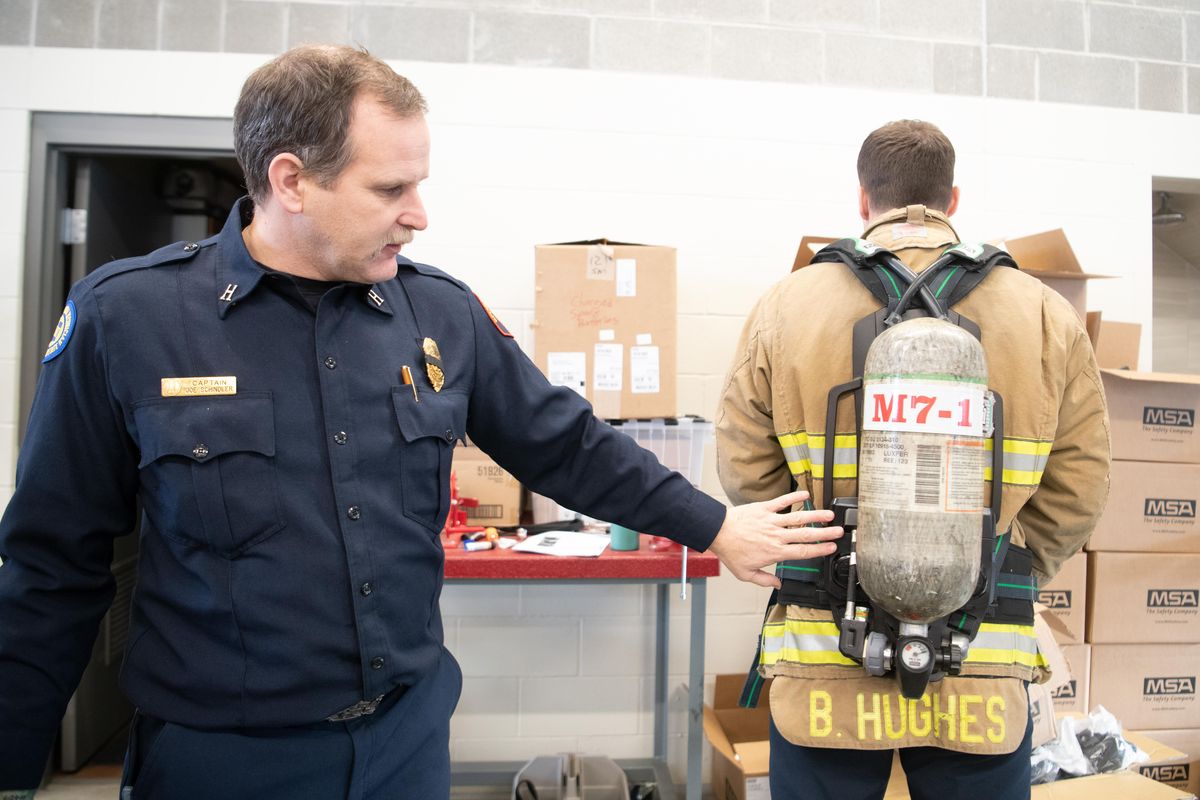Spokane Valley firefighters can breathe easy with new ‘top of the line’ air packs

The Spokane Valley Fire Department is going high tech with new air packs that include several features to improve firefighter safety and make the gear easier to use and clean.
“Our air packs were 12 years old,” said Battalion Chief Ken Capaul. “They met a NFPA (National Fire Protection Association) standard that was 10 years old.”
The new packs, produced by Pennsylvania-based MSA, meet 2019 standards. “These have already passed,” he said. “These are the most current packs on the market today.”
The new masks that come with the packs are slimmed down and roughly a pound lighter, which can make a big difference for firefighters if they spend several hours in their gear fighting a fire. “It’s much more streamlined,” said Capt. Joe Schindler. “All the stuff is on the inside instead of the outside.”
There’s also a voice-amplified speaker worn on the left arm, which should reduce garbled radio transmissions that are sometimes a problem.
The new mask has a nose cup, preventing the mask from fogging up, which has also been a problem, Capaul said. Firefighters often had to labor to breathe with the old masks as they exerted themselves, he said, but people who have used the new masks report that they can draw breaths easily, even when climbing stairs.
“They’ve reported that it’s just like running up the stairs without anything on their face,” Capaul said.
Each pack has a thermal imaging camera attached, which can be used to find fire hidden inside walls or people in a smoke-filled environment. “You can do a search much quicker,” said Schindler. “He can walk around the outside of a structure and find a heat source.”
The department currently has one thermal imaging camera on each truck, but having each firefighter wear a camera is also a safety feature, Capaul said. The cameras can be used to locate exterior doors and windows, which are cooler, to help firefighters who get disoriented inside a burning building. That’s been a problem across the country, he said.
“Dozens of firefighters over the years have died because they got lost in a building and couldn’t find their way out,” Capaul said.
The department also has 17 new rescue air kits. The packs have a special valve on the bottom where a new air bottle can be attached if a firefighter is down and running out of air. The rescue air kits are used to connect to the valve to transfer more air.
The new packs have flashing lights on the front and back that show the amount of air available, which lets battalion chiefs know at a glance who needs to be pulled out to replenish their air, Capaul said. The lights flash green if the air tank is over 75 percent full, yellow when it’s between 75 and 50 percent and red if it falls below 50 percent.
Changing an air tank is much faster because the new packs have a quick release system that allows the tanks to be changed in seconds rather than threaded on.
The shoulder straps were even designed in such a way that they won’t slip from a firefighter’s shoulders. “The straps area crossed,” said Capaul. “That keeps the shoulder straps on his shoulder. Before they would tend to fall off.”
There’s an adjustable lumbar support that bears most of the weight of the pack, and it pivots so the air tank stays in place when a firefighter bends and pivots. The packs break down easily for cleaning, which is done after every fire to clean off the carcinogenic smoke.
“They’re a lot easier to clean,” Schindler said. “We have no more electronics on the masks. We can just dip it in and clean it off.”
The old packs and masks could not be properly cleaned, leaving a smoky, toxic residue behind, he said. “Fires are so much more toxic now, and these air packs help that.”
These days more firefighters die from job-related cancers than fighting fires, Capaul said. “We know it comes from our dirty gear,” he said.
The department ordered 86 air packs at a cost of $600,000 after spending the last two years researching and testing new models.
“This is a big purchase,” Capaul said. “These will be in use for 10 or 15 years.”
The department did save $200,000 by reusing their old air tanks, also produced by MSA. They were adapted to fit the new packs.
There is a new air pack at every station for firefighters to practice with and they are using them in training. Every firefighter will have to pass a written test proving mastery of the new tanks before they go into service across the department, which Capaul hopes will happen at the beginning of February.
“This is top of the line from a firefighter safety perspective,” he said.